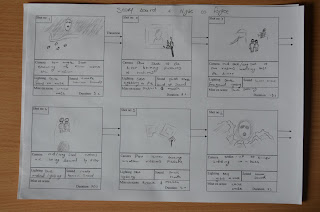7.
Looking back at your preliminary task (the continuity editing task), what do
you feel you have learnt in the progression from it to full product?
Since our Preliminary Task we have learned and widened our experiences with camera's and the use of different camera angle's.180 Degree Rule
The 180 Degree rule is used as a filming guideline that participants in a scene should have the same left/right relationship to each other, filming should only take place within the 180 degree angle for example, if two people were holding a conversation the camera would only stay on the left/right side of the people talking- For example, in our final project we made sure when using the 180 degree rule the shots flowed more smoother trying not to make continuity or any technical errors, at first we struggled using this shot in our preliminary task due to our lack of understanding and practise, we practised our techniques for this technique in many shots, and also produced some research on how we could use this rule to its full potential in our main production, unlike on the preliminary our skills were basic due to lack of practise and knowledge.
Match on Action
Match on action is for example, if a person walked down through a corridor and then went to open a door, a camera can zoom in on the same persons's hand opening the door, it is also a cut or action or even a movement between to certain shots- same as 180 degree rule, this technique took time and practise, we got to use this during the film excessively, as we only used this shot a number of times, but when this came to our main production we took time to focus on how we could get this shot as good as we can, this was done as a team effort throughout.
Shot/Reverse Shot
 For example this means if two people was having a chat facing each other, the camera would take the view of a person listening to the other person speak, usually a view from a persons shoulder- we used this technique through the whole of our preliminary, as this was our first time we sturggled to pull this off smoothly, due to a large gap of time we had to make our main production we resaerched tips on how to use the shot to its full effectiveness, we also had group meet ups, to decide how we could apply what we learnt into our shots.
For example this means if two people was having a chat facing each other, the camera would take the view of a person listening to the other person speak, usually a view from a persons shoulder- we used this technique through the whole of our preliminary, as this was our first time we sturggled to pull this off smoothly, due to a large gap of time we had to make our main production we resaerched tips on how to use the shot to its full effectiveness, we also had group meet ups, to decide how we could apply what we learnt into our shots.






















